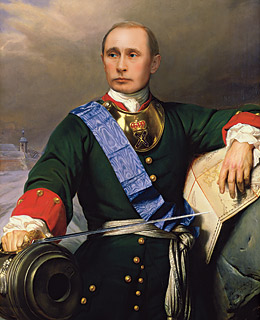|
People are comparing Vladimir Putin to the Russian tsar Peter the Great.
By some weird coincidence, I recently read “Peter the Great: His Life and World,” which earned Robert K. Massie the Pulitzer Prize in 1981. It is one of the greatest biographies I have ever read. Putin’s concern with expanding toward salt water may sound like Peter, but Putin does not demonstrate the curiosity and complexity of the tsar (1672-1725.) As tsar, Peter lived in the Netherlands for several years, learning how to build ships with his own hands. He encouraged European ways, first in Moscow, later in St. Petersburg. He also invaded, killed, tortured – all of that, too. In the current turmoil in Ukraine, the real comparison is between women. The other day at the naval base in Crimea, the wives of Ukrainian naval men stood watch outside the garrison. If Russian soldiers came any closer, they would have to face the women first. The stirring eyewitness report was in the Times: http://www.nytimes.com/2014/03/05/world/europe/no-bloodshed-in-a-standoff-at-an-airfield-in-ukraine.html The women had a spiritual ancestor in Catherine, the second wife of Peter the Great, who also faced potential disaster. Their union was one of the better love stories in history – a teen-age immigrant who impressed a tsar, became his wife, calmed him during his seizures, advised him, even cautioned him. And once accompanied him toward battle. In July of 1711, Peter got himself surrounded by Ottoman forces on a foray to the Pruth River, which flows from Ukraine toward the Danube. “In the center of the camp, a shallow pit had been dug to protect Catherine and her women,” Massie writes. “Surrounded by wagons and shielded from the sun by an awning, it was a frail barrier against Turkish cannonballs. Inside, Catherine waited calmly, whilke around her the other women wept.” For some reason, the Ottoman leader allowed Peter and his army to escape, in exchange for land that will sound familiar today. Peter lived to strengthen his empire, and the next year he re-married Catherine in a more formal ceremony. “Two years later, Peter further honored Catherine by creating a new decoration, the Order of St. Catherine, her patron saint, which consisted of a cross hanging on a white ribbon, inscribed with the motto, ‘Out of Love and Fidelity to My Country.’” Massie adds: “The new order, Peter declared, commemorated his wife’s role in the Pruth campaign, where she had behaved ‘not as a woman but as a man.’” The brave women outside the garrison in Crimea deserve a medal, also.
Thor A. Larsen
3/7/2014 02:26:09 am
Excellent article, George! 3/7/2014 03:31:32 am
George
George Vecsey
3/7/2014 03:42:50 am
Alan and Thor, thanks.
Brian Savin
3/8/2014 01:28:02 am
A new Battle of Balaclava, and a new Light Brigade.
George Vecsey
3/8/2014 03:23:49 am
When will they ever learn?
Brian Savin
3/9/2014 12:26:18 pm
Yes, and where have all the roses gone, brother? Comments are closed.
|
Categories
All
|











